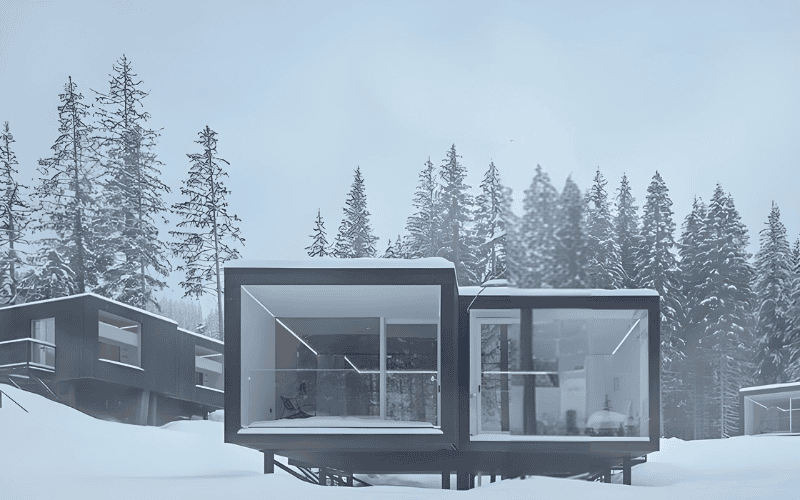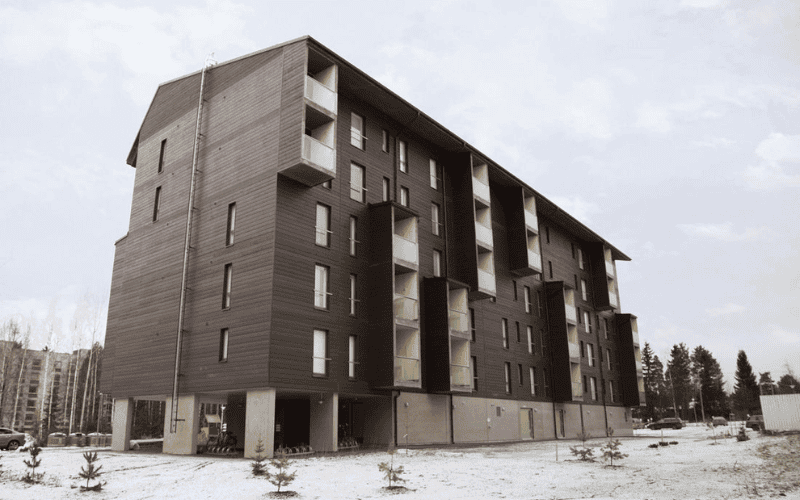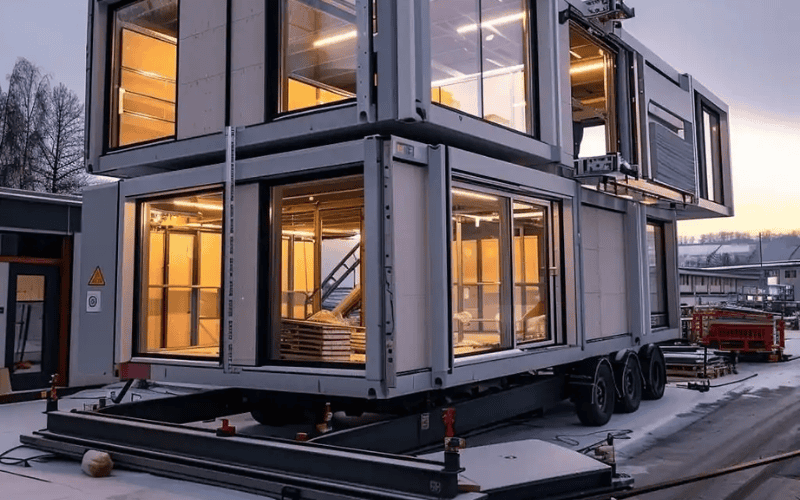The impact of cold winter weather on the living environment cannot be ignored, especially for modular and mobile homes. Due to their unique structural characteristics, prefabricated modular homes require additional protective measures to ensure that residents are warm, safe and energy-efficient. Taking winter protection in advance can not only improve living comfort and reduce heating costs, but also improve the durability of the house.
We will help everyone ensure that modular homes are warm, safe and energy-efficient in winter through 13 practical winter protection tips. Whether you have already moved in or are preparing to move in, mastering these protective measures can make your winter more comfortable and secure.
Modular Winterizing Tip 1: Seal the gaps around doors and windows
During winter, the spaces surrounding doors and windows frequently serve as the primary entry points for cold air. To maintain warmth inside the room, begin by inspecting and sealing these gaps. Employ caulking or specialized sealing strips to close off the edges of doors and windows, thereby preventing the infiltration of cold air.
Also, check the door and window frames for cracks or damage, especially after using them for a while. As soon as you notice any cracks, repair them promptly to guarantee the effectiveness of the seal. With these simple measures, you can not only effectively block out cold air, but also improve the energy efficiency of your home and reduce the energy waste for heating.
Modular Winterizing Tip 2: Check the roof and drainage system
Snow and freezing weather in winter can put extra pressure on the roof, so it is important to check the roof and drainage system regularly. First, clean the roof and gutters to make sure there is no snow, dead leaves or debris blocking them. This will prevent snow accumulation and ice dams from forming, avoiding moisture leakage or roof damage.
Additionally, inspect the roof for any cracks or other potential damage. Cracks in the roof can cause heat loss or water leakage, which can affect the insulation and safety of the house. Repair problems as soon as they are discovered to ensure that your roof is able to withstand the cold weather and precipitation during the winter. Through regular maintenance, you can substantially prolong the lifespan of your roof and ensure your home remains both safe and warm.
Modular Winterizing Tip 3: Protect your pipes
In the winter, exposed pipes can easily freeze due to low temperatures, causing pipes to crack or leak. Therefore, protecting your pipes is a key measure to prevent winter disasters. You can use insulation (such as pipe insulation sleeves) or heating tape to wrap exposed pipes to keep them warm and avoid freezing.
Furthermore, especially on extremely cold nights, consider allowing your faucets to drip slightly. This practice helps maintain water circulation in the pipes and minimizes the chance of them freezing. With these simple precautions, you can ensure that your pipes function properly in cold weather and avoid unnecessary repairs and losses.
Modular Winterizing Tip 4: Add Insulation
To improve your home’s winter insulation, you can add extra insulation to the walls, roof, and floors. Doing so will not only diminish heat loss but also significantly enhance your home’s energy efficiency, thereby keeping the room warmer. Common insulation materials include fiberglass, foam board, or spray-on insulation, all of which can help keep the cold out.
Pay special attention to the joints in modular homes, which can easily become a weak link for heat loss. Inspecting and reinforcing these joints can prevent unwanted heat loss and boost the insulation capabilities of your home. In this way, you can not only reduce your heating bills, but also improve your overall comfort and enjoy a warmer winter.
Modular Winterizing Tip 5: Use Ceiling Fans in Reverse Direction
To increase heating efficiency during the winter, you can set your ceiling fans to rotate in a clockwise direction. This will push warm air from the ceiling downward, helping to evenly distribute the warm air throughout the room and avoid heat concentrating in the upper part of the room, resulting in lower temperatures in the lower areas.
This method not only increases indoor warmth, but also reduces the frequency of heating equipment use, thereby reducing energy consumption. Simply adjusting the direction of your ceiling fan can effectively improve your home’s heating efficiency, which is an energy-saving and practical winter protection tip.

Modular Winterizing Tip 6: Check and maintain your HVAC system
Maintaining your HVAC system in optimal condition is crucial for effective winter heating. First, it is recommended to replace your HVAC filters once a month to ensure smooth air circulation. Dirty and clogged filters not only affect air quality, but also make your heating system less efficient and increase energy consumption.
In addition, cleaning your condenser coils once a quarter to remove dust and dirt will help keep your system in optimal working condition. This will greatly improve system efficiency, ensure that heat is evenly distributed, and avoid unnecessary energy waste caused by system failure or inefficiency. Maintaining your HVAC system in optimal condition is indeed crucial for achieving efficient winter heating.
Modular Winterizing Tip 7: Clean your gutters and sewers
Cleaning your gutters and sewers during the winter is an important step to prevent clogging and freezing of your plumbing system. Fallen leaves, dirt, or other debris can easily accumulate in gutters, blocking water flow, leading to water accumulation and ice dams. Especially when the temperature drops sharply, the accumulated water can easily freeze, causing the drainage system to be blocked or damaged.
Regularly cleaning the gutters and sewers to ensure smooth drainage can effectively prevent these problems. This not only avoids pipe damage caused by freezing, but also protects the house from water damage, ensures that the moisture from rain and snow in winter can be drained smoothly, and maintains the safety of the house structure.
Modular Winterizing Tip 8: Prune plants
In winter, if trees and shrubs close to the house are not pruned in time, snow and frost may cause branches to break, which in turn damages the exterior structure of the house. Therefore, regularly pruning these plants, especially those close to the roof, windows and exterior walls, can effectively reduce the potential threat of winter wind and snow to the house.
In addition, make sure that plants do not block vents or drainage systems. Plant growth may block vents and affect air circulation, and may also block gutters and cause poor drainage. Keeping plants properly pruned will help keep the environment around the house clean and unobstructed, thereby improving the winter protection effect of the house.
Modular Winterizing Tip 9: Check your foundation
When the temperature drops sharply in winter, freezing of the ground can cause stress on the foundation of your home, and even cause your home to sink or become unstable. Hence, regularly inspecting your foundation is of utmost importance. Make sure your home’s foundation is stable to prevent frozen ground from affecting the structure, especially in cold regions.
For modular homes, it is also important to check the supporting structure. The supporting columns or foundation base need to be stable to prevent the supporting points from loosening due to freezing or soil erosion. By checking and maintaining your foundation in a timely manner, you can effectively prevent possible foundation settlement problems in winter, ensure that your home is safe and stable, and reduce the cost of repairs caused by foundation problems.
Modular Winterizing Tip 10: Use energy-saving windows and doors
In order to effectively reduce heat loss, installing double or triple glazed windows is a very effective measure. This window design can effectively block out the cold air from the outside while retaining the heat inside, greatly improving the energy efficiency of the home.
Furthermore, verify the seals on doors and windows to ascertain their integrity. If the seals are old or damaged, cold air will penetrate and increase the heating burden. Replacing or repairing seals in time and ensuring the sealing performance of doors and windows can effectively reduce heat loss, improve living comfort, and help save energy bills.

Modular Winterizing Tip 11: Control indoor humidity
In winter, high indoor humidity will not only make the air feel colder, but may also cause the growth of mold and mildew, which will affect indoor air quality and health. To prevent moisture accumulation, use a dehumidifier or heater to adjust the indoor humidity level.
It is ideal to keep indoor humidity between 30% and 50%, which helps reduce the risk of mold growth and improve living comfort. Especially during the heating period, when the air is drier, moderately increasing humidity can prevent dry skin and prevent wood furniture and floors from shrinking or deforming due to drying. Check humidity levels regularly to ensure fresh and healthy indoor air.
Modular Winterizing Tip 12: Install a smart thermostat
Installing a smart thermostat is a very practical option to improve energy efficiency in winter. A smart thermostat can automatically regulate the heating system in response to fluctuations in indoor and outdoor temperatures, ensuring that the house consistently maintains a pleasant temperature. It can also set a reasonable temperature control schedule based on your daily living habits to avoid wasting energy.
For instance, when nobody is at home, the smart thermostat automatically reduces the temperature to prevent wasteful heating. When you return home, it adjusts the temperature in advance to ensure that you can enjoy a warm environment as soon as you enter the door. With such intelligent control, you can not only improve living comfort, but also effectively save energy costs.
Modular Winterizing Tip 13: Check the ventilation system
Ensuring that the ventilation system is working properly is essential to maintain indoor air quality in winter and prevent moisture accumulation. If moisture is not effectively discharged, it may cause mold growth, wood rot and even affect the structure of the house.
Clean vents, exhaust fans and ventilation ducts regularly to ensure smooth air circulation. Especially in places where moisture is prone to occur, such as kitchens and bathrooms, make sure that the exhaust system is not blocked to avoid moisture stagnation. In addition, checking whether the indoor air circulation is even and ensuring that each room is fully ventilated will help keep the indoor air fresh and healthy.
Modular Winterizing Tip 14: Prepare emergency tools
Sudden situations such as winter blizzards and power outages may affect the heating and safety of the house, so it is important to prepare emergency tools in advance. Make sure you have snow shovels and snow melters at home to deal with snow accumulation and freezing conditions, and keep doorways, walkways and gutters clear to avoid hidden dangers around the house caused by snow accumulation.
In addition, preparing a backup power supply or generator is also key, especially in areas with unstable power supply. If there is a power outage, the backup power supply can ensure that the heating system and other key equipment continue to operate and avoid a sharp drop in indoor temperature. With these preparations, you can more calmly deal with emergencies and ensure safety and comfort in winter.
Modular Winterizing Tip 15: Regularly inspect the house
Before the arrival of winter every year, it is recommended to have a professional conduct a comprehensive inspection of the house to ensure that all facilities and structures are in good condition. Pay special attention to the joints of modular houses to check for heat loss or poor sealing to ensure that the insulation effect is not affected.
At the same time, check the pipes and heating systems to ensure that there are no leaks, blockages or other potential failures. Timely maintenance and inspection of these key components can effectively avoid unexpected failures in winter and ensure that the house is warm and safe during the cold season. Regular professional inspections can help you be fully prepared before the cold weather arrives, avoiding unnecessary trouble and repair costs.

Summary
Winter is coming soon, so follow these steps to check and protect your house before the cold weather. As a company specializing in modular construction, we provide not only high-quality building materials, but also customized steel structure solutions to ensure that your house is best protected in every aspect.
Whether it is through efficient insulation materials or solid structural design, we are committed to creating a warm, safe and energy-saving living environment for you. Start preparing now to give your home a warm and safe winter!
Related Reading: Cheapest Way to Insulate a Metal Building

